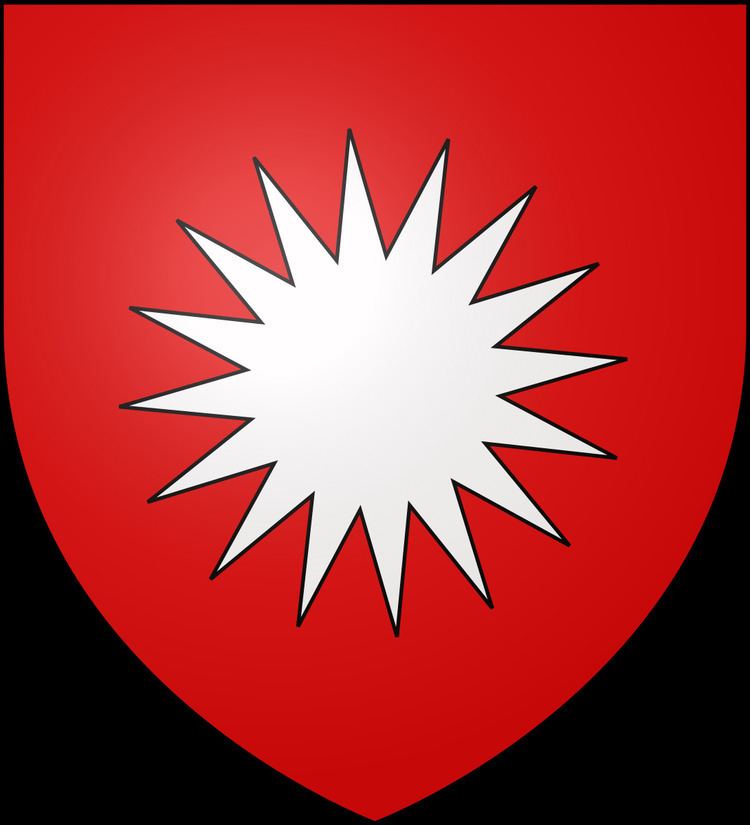 | ||
The House of Baux is a French noble family from the south of France. It was one of the richest and most powerful families of Medieval Provence, known as the 'Race d’Aiglon'. They were independent Lords as castellan of Les Baux and Arles and wielded very considerable authority at local level. They held important fiefs and vast lands, incl. the principality of Orange.
Contents
- Lords of Baux
- Lords of Berre Meyragues Puyricard and Marignane
- Princes of Orange
- The ancestors of the Lords of Baux
- Simplified Family Tree of the Lords of Baux
- References
In Provençal, the word “Baux” ( "li Baou" in provencal) means escarpment/cliff, and refers to the natural fortress on which the family built their castle, the Château des Baux and the village that surrounded it. The word is also seen in Bau-maniere, Bau-baisse, Bau-mirane, Bau-Cous-temple. In provencal to be from les Baux, des Baux, was "de Baucio". The natural defense provided by the escarpment, the raised and protected mountain valley that allowed them to have a protected food supply, and the natural ridge of the Alpilles that allowed them to control all the approaches to the citadel of Les Baux and the surrounding countryside, including the passage up and down the Rhone, and the approaches from the Mediterranean, made that the fortress impervious to the military technology of the time.
The family of des Baux exists today in Naples in the person of several noble families ("del Balzo") descended from younger sons who followed Charles of Anjou south. After the death of Alix des Baux, the last sovereign of Baux, the chateaux and town were seized by King Rene, who gave it to his 2nd wife, Queen Jeanne of Laval. When Provence was united with the crown, almost 150 yrs of royal governors followed, including the lords, later counts and princes de Manville. Les Baux became a centre for Protestantism. Its unsuccessful revolt against the crown led Cardinal Richelieu in 1632 to order that the castle and its walls should be demolished. This was accomplished with the aid of cannon.
Lords of Baux
The earliest definite ancestor was one Pons (Poncius) (name could designate a trader from Greece) "Iuvenis" (the younger, meaning there was an older?). Pons The Younger was mentioned in 3 legal acts:
The family descent then is:
This branch of the House of Baux was declared extinct in 1426. The domains were inherited by Counts of Provence.
Lords of Berre, Meyragues, Puyricard and Marignane
From this branch originated the family branches of the Seigneurs de Berre, Lords of Meyrargues and Puyricard, who became extinct in 1349, and lords of Marignane, acquired by House of Valois-Anjou, as well as the Dukes of Andria.
Princes of Orange
In 1417 the House of Ivrea or House of Châlon-Arlay succeeded as princes of Orange.
A brother of William I started the branch of the Lords of Courbezon (House of Baux-Courbezon), which became extinct in 1393. Another brother started the line of Lords of Suze, Solerieux and Barri (House of Baux-Suze-Solerieux-Barri), which became extinct and reverted afterwards to the counts of Orange.
The ancestors of the Lords of Baux
The ancestors of the Lords of Baux:
Leibulf de Provence (vers 750-835) x Odda ? | | → Leibulf des Baux (middle of the 9th century). x ?? | | → Pons d’Arles (end of the 9th century) x Blismodis de Mâcon | | → Humbert, Bishop of Vaison-la-Romaine (890-933) | | → Ison d’Arles (890-942), x Princess ? of Benevento | | → Lambert Ursus seigneurs de Reillanne | x Galburge de Bénévent | | | | → Seigneurs de Reillanne | | → Pons de Marseille (910-979), x Judith de Bretagne, daughter d'Alain II de Bretagne | | → Honoratus de Marseille (930-978), Bishop of Marseille | | → William of Marseille (935-1004) | x Bellilde, daughter d’Arlulf de Marseille | | | | → Vicomtes de Marseille | x Belletrude | | → (hyp) Pons de Fos (vers 945-1025) x Profecta de Marignane | | → Seigneurs de Fos | | → (hyp) Hugues des Baux (981-1060) x Inauris de Cavaillon (?) | | → Guillaume Hugues de Baux (1060–1095) x Vierne | | → Raymond-Raimbaud des Baux (1095–1150) x Étiennette de Gévaudan | | → Bertrand des Baux x Thiburge II d'OrangeSimplified Family Tree of the Lords of Baux
The family tree of the lords of Baux (per the references cited in the adjacent footnote, rather than footnote each person, as they are from all these sources):
